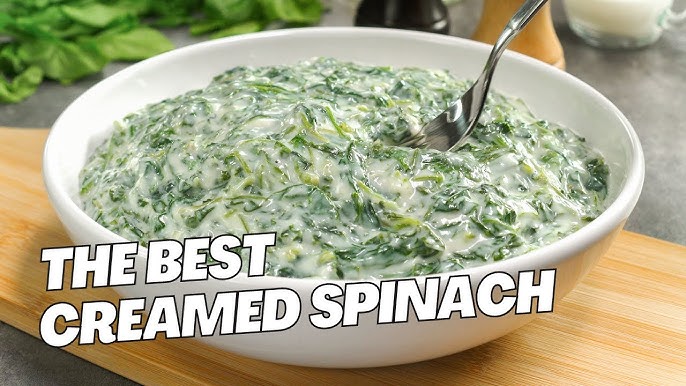Creamed Spinach Recipe: Creamed spinach is a delicious and creamy side dish that pairs beautifully with steak, chicken, and a variety of other main courses. This easy-to-follow recipe will guide you through every step to make perfect, restaurant-style creamed spinach at home. Whether you’re preparing a holiday meal or just looking to add a tasty side to dinner, this dish is sure to impress.
Ingredients Needed for Creamed Spinach
To create the rich and flavorful sauce, you’ll need a few simple ingredients:
- Fresh Spinach: Use about 1 pound of fresh spinach for a small batch or 2 pounds for a larger serving. Baby spinach works best as it’s more tender and easier to clean.
- Butter: A couple of tablespoons to sauté the spinach and start the sauce.
- Onion and Garlic (optional): These add depth and complexity to the flavor. About 1/4 cup of minced onion and 1-2 cloves of garlic, finely chopped.
- Heavy Cream or Half-and-Half: For a rich, creamy base. You’ll need about 1 cup.
- Cream Cheese or Parmesan Cheese: Adding a bit of cheese thickens the sauce and adds a savory element. Use about 1/4 cup.
- Flour (optional): To help thicken the sauce if desired. A tablespoon or so is usually enough.
- Nutmeg, Salt, and Pepper: Nutmeg is a classic seasoning in creamed spinach, giving it a warm and aromatic flavor.
Kitchen Tools Required
Here’s a quick rundown of the essential tools:
- Large skillet or saucepan
- Wooden spoon or spatula
- Measuring cups and spoons
- Cutting board and knife
Preparation Steps Before Cooking
1. Prep the Spinach
Rinse your spinach thoroughly to remove any dirt or sand. Pat it dry with a clean kitchen towel or paper towels. This helps prevent extra water from diluting the sauce.
2. Measure Out Ingredients
Organize your ingredients ahead of time to make the cooking process smoother. Pre-measure the butter, cream, flour, and seasonings to save time.
Step-by-Step Creamed Spinach Recipe
Step 1: Sauté the Spinach
- Heat the Butter: Place a large skillet over medium heat and melt 1 tablespoon of butter.
- Add Spinach: Add the spinach in batches, stirring frequently as it wilts. Spinach cooks down quickly, so keep adding fresh handfuls until all of it is in the pan.
- Cook Until Wilted: Sauté the spinach for 3-4 minutes, just until it’s wilted. Be careful not to overcook, as this can lead to a mushy texture.
Pro Tip: To keep the spinach looking bright and green, cook it quickly and avoid excessive stirring.
Step 2: Prepare the Cream Sauce
- Melt More Butter and Add Flour (Optional): In the same skillet, add another tablespoon of butter. If you’re using flour, add it here and whisk it into the butter to create a roux.
- Pour in the Cream: Slowly pour in the cream while continuing to stir. This prevents lumps and ensures a smooth sauce. Cook for 3-4 minutes, stirring continuously until the sauce thickens slightly.
- Add Cheese for Extra Creaminess: Add the cream cheese or grated Parmesan, stirring until it melts and blends into the sauce.
Tip: The key to a smooth, creamy sauce is to keep stirring and avoid adding the cream too quickly.
Step 3: Combine Spinach and Sauce
- Add the Spinach to the Sauce: Gently fold the sautéed spinach back into the pan with the cream sauce.
- Stir Until Evenly Coated: Use a spatula to gently coat the spinach in the sauce without over-mixing, which can make the spinach mushy.
- Adjust the Consistency: If the sauce is too thick, you can add a splash of milk. If it’s too thin, cook it a bit longer to reduce.
Step 4: Season and Adjust Flavor
- Season with Salt, Pepper, and Nutmeg: Start with a small pinch of salt and pepper, tasting as you go. Nutmeg should be added sparingly, as it can quickly overpower the dish.
- Taste and Adjust as Needed: This is your chance to balance the flavors. If the dish feels too rich, a pinch of lemon zest can brighten it up.
Optional Add-ins for Extra Flavor
- Cheese: Parmesan, Gruyère, or even blue cheese can add depth.
- Garlic: For an added kick, sauté garlic with the spinach.
- Bacon or Mushrooms: Crispy bacon or sautéed mushrooms bring a unique twist to the dish.
Finishing Touches and Garnishing Ideas
A light sprinkle of grated Parmesan or fresh herbs like chives or parsley makes a great garnish. For a dash of color, add a sprinkle of paprika before serving.
Serving Suggestions for Creamed Spinach
Creamed spinach is the perfect companion for:
- Grilled or Roasted Meats: Think steak, chicken, or pork chops.
- Seafood: Try it with salmon or grilled shrimp.
- Baked Dishes: Creamed spinach also pairs well with lasagna or baked ziti.
Storage and Reheating Tips
- Storing: Store leftover creamed spinach in an airtight container in the refrigerator for up to 3 days.
- Reheating: Reheat gently on the stovetop over low heat, adding a splash of cream to restore the creamy texture.
Tips for Making the Best Creamed Spinach
- Avoid Overcooking: Spinach can become mushy if cooked too long. Keep an eye on it.
- Balance the Cream and Cheese: Too much cheese can overwhelm the spinach, so add cheese sparingly.
- Taste as You Go: Adjust salt, pepper, and nutmeg carefully to avoid overpowering flavors.
Variations on Creamed Spinach
- Healthier Option: Substitute cream with Greek yogurt or low-fat milk.
- Vegan Alternative: Use coconut milk and a dairy-free butter substitute.
- Dairy-Free: Almond or cashew milk work well as a replacement for cream, though they’ll alter the flavor slightly.
FAQs about Creamed Spinach Recipe
1. What is creamed spinach?
Creamed spinach is a classic side dish made with fresh or frozen spinach, cooked in a creamy sauce often seasoned with garlic, onions, and a hint of nutmeg. This rich, savory dish pairs perfectly with roasted meats, making it a popular choice for holiday meals or cozy dinners.
2. Can I use frozen spinach for creamed spinach?
Yes, frozen spinach works well in creamed spinach recipes. Just make sure to thaw and squeeze out excess water to prevent the dish from becoming too watery.
3. How can I make creamed spinach healthier?
For a lighter version, substitute heavy cream with milk or a blend of milk and Greek yogurt. You can also use olive oil instead of butter to cut down on saturated fats.
4. Can I make creamed spinach in advance?
Absolutely! You can prepare creamed spinach a day in advance and reheat it before serving. To retain its creamy texture, reheat on low heat and add a splash of cream or milk if needed.
5. What goes well with creamed spinach?
Creamed spinach pairs excellently with dishes like grilled steaks, roasted chicken, or even salmon. Its rich, creamy flavor balances well with roasted or grilled main courses, adding a deliciously comforting touch to your meal.
Conclusion
Creamed spinach is a luxurious and satisfying side that’s easier to make than you might think! This step-by-step guide should help you master a classic creamed spinach that will elevate any meal. Experiment with different cheeses and flavors to make it your own. Enjoy the delicious, creamy flavors of homemade creamed spinach!
References
For readers interested in deepening their understanding or validating the information provided in our Creamed Spinach Recipe, here are some reputable sources to explore:
- Food Network: Known for its trusted recipes and cooking tips, Food Network offers a variety of creamed spinach recipes with expert insights and alternative preparation methods.
- Bon Appétit: This renowned culinary site provides detailed, chef-approved recipes and offers guidance on ingredients, seasoning, and techniques for perfecting creamed spinach.
- AllRecipes: With thousands of user reviews and ratings, AllRecipes shares easy-to-follow instructions, common substitutions, and tips from home cooks, adding practical perspectives on classic dishes like creamed spinach.
- Serious Eats: This source dives into the science behind cooking, ensuring readers understand the “why” behind every step, making it ideal for those who want a thorough approach to creamed spinach.
These references ensure accuracy, provide varied approaches, and offer trusted resources for readers aiming to master or experiment with this comforting, flavorful dish.



